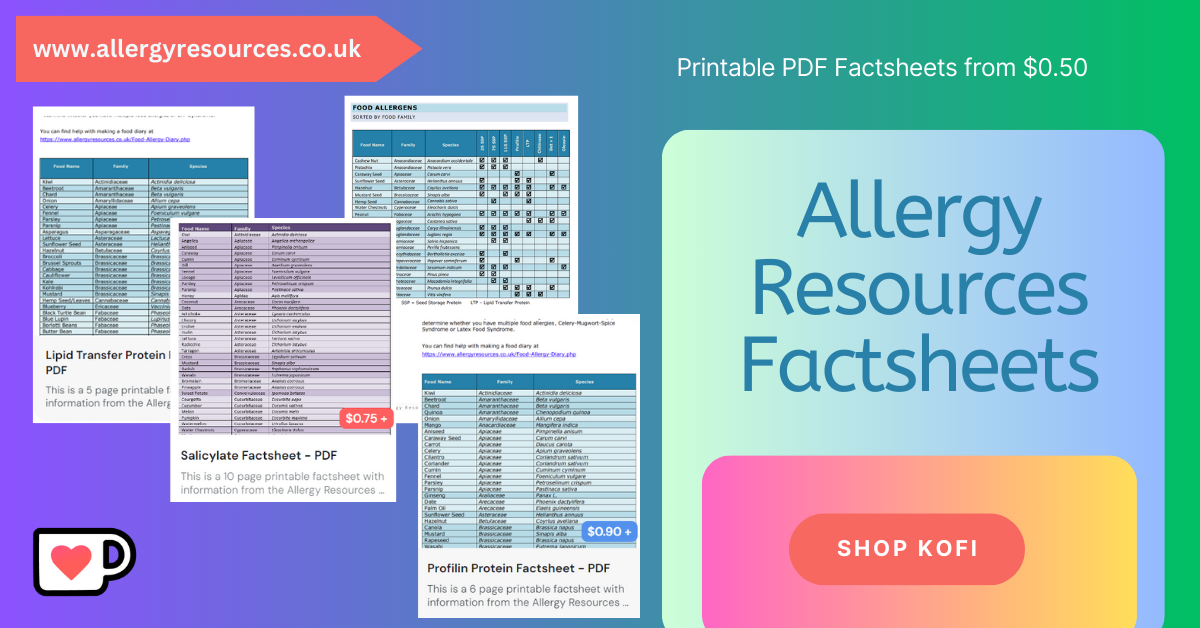
MUSTARD ALLERGY
Key Allergens
There are two types of mustard plant with allergens recognised by the World Health Organization, Oriental Mustard and Yellow Mustard.
Oriental mustard only contains one allergen, Bra j 1, which is a 2S seed storage protein commonly found in nuts and seeds.
Yellow mustard has 4 food allergens. Sin a 1 is also a 2S seed storage protein and Sin a 2 is an 11S seed storage protein.
Sin a 3 is a Lipid Transfer Protein (LTP) and Sin a 4 is a profilin protein. These are all panallergens, proteins which can cause allergies over a larger groups of foods which are sometimes seemingly unrelated.
Unprocessed mustard seeds have been shown to contain furanocoumarins. These chemicals can get on the skin and in combination with ultraviolet light (sunlight) can cause a sunburn like rash. Furanocoumarins are found in higher concentrations in fresh herbs and are natural irritants which can cause allergic contact dermatitis. This is more common in occupations where you are frequently coming into contact with the food, like chefs, cooks, growers and pickers.
Food Intolerances


Fresh mustard is low in sulphites, but any processed mustard may contain moderate amounts, this should be indicated on the label. Sulphites are inorganic salts used in preservations and have the potential to cause symptoms of food intolerance to those sensitive to sulphites, this food intolerance is more common in asthmatics. An improvement in symptoms can be made with a change to a low sulphite diet.
Mustard seeds are high in salicylates. Salicylates have the potential to cause worsening of asthma, swelling, itching and hives as well as food intolerance symptoms in people who are sensitive to salicylates.
You can read more about Food Intolerances on the dedicated Food Intolerance Page.
Associated Syndromes
Allergy to mustard seed is sometimes linked to Celery-Mugwort-Spice Syndrome as the sensitising allergen is a profilin protein called Art v 4, these proteins are also sometimes also called Bet v 2 proteins.
There is also a link between mustard and Latex Food Syndrome. The plant involved in latex allergy Hevea brasiliensis, the rubber tree plant, has an allergen called Hev b 8 which is a profilin protein. Those very sensitised to latex may have a contact allergic reaction from other foods or plants containing profilin proteins, there is less evidence of this than sensitisation to other latex linked proteins like hevein and chitinases.
Cross Reactivity
Other food containing 11S proteins (not already mentioned above) are pumpkins, walnuts and almonds.
Common foods involved in LTP allergy include kiwi, strawberries, sunflower seeds, walnut, apple, mulberry, banana, pea, apricot, cherry, plum, almond, peach pomegranate, raspberry, tomato, grape, celery, peanut, asparagus, cabbage, broccoli, chestnut, lemon, tangerine, orange, hazelnut, lettuce, lentils, lupin, green bean, pear, mustard, wheat and maize.
Other foods containing profilin allergens are celery, peanut, soyabeans, lychee, walnut, lupin, almonds, hazelnut, kiwi, pineapple, chilli, melon, orange, strawberry, apple, banana, aubergine (eggplant), peach, pear, tomato, dates, cherry, carrot, barley and wheat. Allergic reactions to some of these foods may be considered a marker of profilin hypersensitivity.
Resources
Websites
Allergen Encyclopedia - Mustard
Anaphylaxis Campaign - Mustard Allergy: The Facts
Allergy information for: Mustard (Brassica nigra, Brassica juncea, Brassica hirta, Sinapis alba)
Types of Mustard - Spread the Mustard
Food Allergy Canada - Mustard Allergy
Lipid Transfer Proteins (LTP Syndrome)
ATP Science - Salicylate Food List
Articles and Journals
Food allergy outside the eight big foods in Europe: A systematic review and meta-analysis, 2024
Mustard Allergy in Children and Cross-reaction: Case Report, 2023
Accidental Reactions to Foods: Frequency, Causes, and Severity, 2022
Biologically Active Compounds in Mustard Seeds: A Toxicological Perspective, 2021
Allergy to LTP: to eat or not to eat sensitizing foods? A follow-up study, 2018
Dangerous anaphylactic reaction to mustard, 2018
2S Albumin Storage Proteins: What Makes them Food Allergens?, 2008
Mustard allergy in children, 2008
Clinical characteristics of patients with mustard hypersensitivity, 2002
Allergy to Mustard Seeds: The Importance of 2S Albumins as Food Allergens, 2001